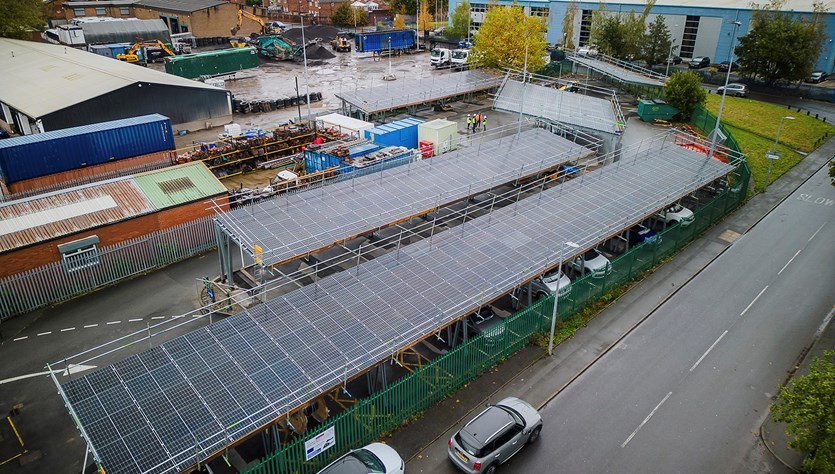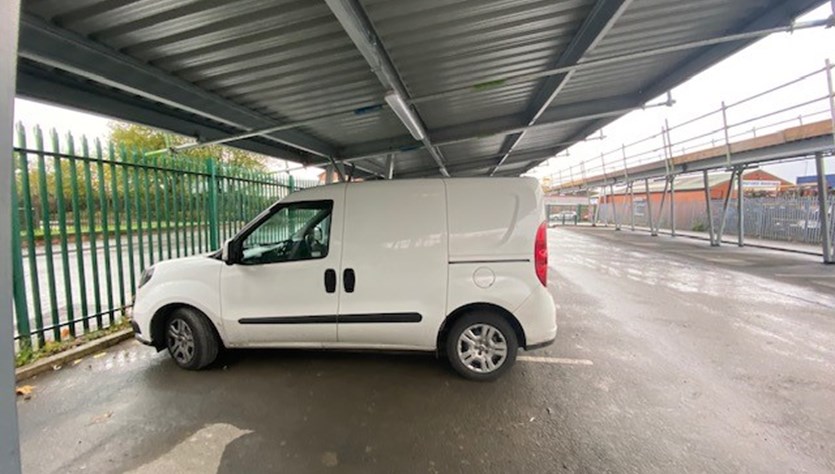Solar car ports are a great way to add renewable energy to your estate, but they are also a specialist technology. We spoke to Vital Energi's in-house solar expert, Dr Alex Marshall about the things you should consider when planning your solar car port project.
The UK’s electricity grid faces a significant problem with connection capacity. Some areas are heavily congested, which can lead to significant connection delays as the core infrastructure is upgraded to support additional generation. In short, some projects will be told there is no grid connection and face a multi-year wait (2030 and beyond), and what could be significant contributory costs, before a space opens up. We recommend liaising with the DNO at the earliest possible convenience to find out if grid connection is possible, but even if you receive a no, don’t panic! We have worked with clients who have initially received a “no” from their DNO, but have worked with them to create innovative and viable projects which have been successfully delivered .
You should also remember that projects over 1MW trigger a full statement of works review, which can take up to 18 months, so this needs to be factored into your timescales.
Also, remember if you’re exporting to the grid, you’ll need to submit a full G99 application. The feedback from this will dictate if you need to pay for upgrades and notify you of what you need to do to gain full compliance.

Solar Car Ports open up the possibility of using under-utilised space to generate clean electricity alongside the possibility of creating a new revenue stream.
Again, early engagement is key. When we’re acting on behalf of a client our first course of action is to reach out to the planners and talk through what we’ve got in mind. Then you’ll have a decision to make about whether to go for outline planning permission, or full planning permission.
If you opt for outline planning permission initially, it will give an opportunity for people to react to your scheme. These range from utilities, national grid, fire, transport and rail, but also local residents. If done properly this will allow you to identify any objections and address them so that when your full planning application goes in, you’ll have addressed any potential issues.
Planning officers can only make decisions based on the information you give them, so make sure you’ve got the right drawings which include complex layout drawings, GRP enclosures, containment and the routes of your LV/HV cabling. For the frames themselves, planners will need elevation drawings so they can assess how it will sit in the landscape. Detailed design and access statements are also required to provide a comprehensive overview of the scheme.
You may also need to produce ecology surveys, environmental impact assessments and biodiversity plans, showing a net biodiversity gain of at least 10%.
One thing which planners take very seriously is the loss of car parking spaces, especially for organisations with lots of visitors, such as hospitals or universities. Take every effort to reduce any parking space losses, which can include redrawing and reconfiguring your car park.
If you’re not an expert in planning, your contractor should be able to help you at every stage, or handle the entire process for you.
It may not be the most exciting topic, but the quality of the ground which your project will be built on is essential. Understand it and you can create the ideal design, but if you don’t, you can be in for some nasty and expensive surprises.
If your car park is built on “made ground”, or land which has been raised artificially by deposits such as building rubble, then it may not be able to support a solar car port without significant piling or use of concrete ballasts. Simple trial holes early in the project will enable your contractor to assess the ground and the extent of the groundworks necessary to provide a stable base.
Also, check the topography of your land. Solar carports should not be installed at an angle, so if your car park is sloping, your piling system will need to account for this.
Most clients should have an exhaustive map of existing services on their estate, but we find that this can sometimes have been lost or is incomplete. This can lead to unexpected clashes of services and costly delays whilst alternative routes are planned.
If you have an understanding of existing services, that is great. If not, a ground penetrating radar survey will allow you to map all services and avoid clashes, or the potentially expensive solutions needed to overcome them.
All of this advice comes under the simple heading of “Be prepared” and will give you the best chance of a successful project delivered with no nasty surprises.
If you've used the preconstruction period to survey your land and buildings, liaised with planners, spoken to the DNO and got a robust design in place then you have a strong basis to begin your project, but there are some things you'll need to remember...
Your contractor will need a location to set up a compound, but also secure storage. This is essential as solar panels are valuable and can be a target for theft and finding the right location and security measures are paramount.
Depending on the size of your project, you’ll probably have lots of equipment delivered. Make sure you schedule this for when it will have the least impact and make sure you don’t have large trucks coming and going during core commuter or school run times.
The golden rule with deliveries should be “as few as possible during the quietest periods you can find.”
Depending on the size of your project, you should use a phased approach. No client wants to lose complete access to their car park, so by delivering the project in phases, you can maintain access and minimise disruption for service users. Always aim to allow access to the maximum number of car parking spaces at any time.
If you project will result in a road closure, you’ll need a detailed and robust traffic management and you’ll need permission from the Highways Agency. Once again, our advice is talk to them as early as you can so you can build a plan which will create as little disruption as possible to residents and commuters.

It's not only important to reduce car park space losses for your service users... Planners can frown at projects where car parking spaces are lost.
Solar Car Ports are not a plug and play system. They need to be integrated with your existing electrical infrastructure, which in our experience, is generally operating at close to capacity. You may need to extend your switchgear or add another board completely. It's essential you know if this is the case as it will incur budget implications.
How close your solar carports are to where the electricity will be used will dictate if you install a high voltage or low voltage cabling system. If the distance is shorter, you can use low voltage. If it’s further, you may need to use high voltage, which will mean you will need transformers and you will need to give thought to where they will be situated.
An experienced contractor will be able to design a full integration package as part of the design process to ensure your solar car port scheme integrates perfectly with your existing infrastructure.
If your solar car ports are feeding into your estate, then have you considered reducing your electricity needs so you become more self-sufficient.
Simple things such as lighting upgrades and improvements to your HVAC system can save tonnes of carbon each year, whilst reducing your energy demand. This means that the solar electricity generated will supply a greater percentage of your usage.
Energy conservation measures are fantastic complimentary technologies to solar installations.
Each installation is unique… Are you planning to export to the grid? Are you utilising battery energy storage? Are you providing electric vehicle charging points?
You will have a list of things you want your installation to achieve, and the design process is the opportunity to make sure this will happen.
Be extremely wary of “off the peg” solutions… Make sure your design is as original as your idea and every element is tailored to making it a success and based on solid data analysis and modelling. You should look to the future to understand your broader Masterplan, so you can develop a futureproofed solution that will benefit your organisation in the long run.